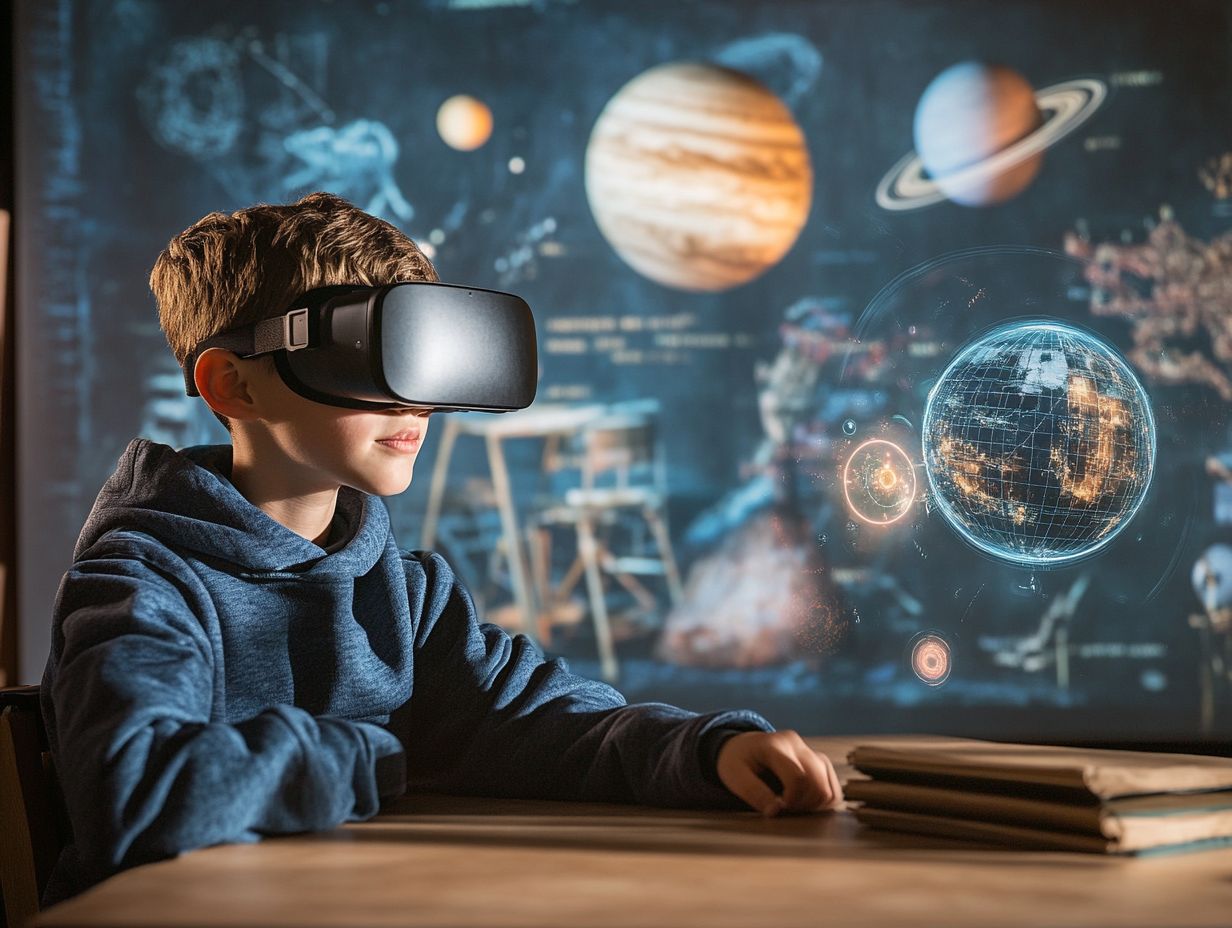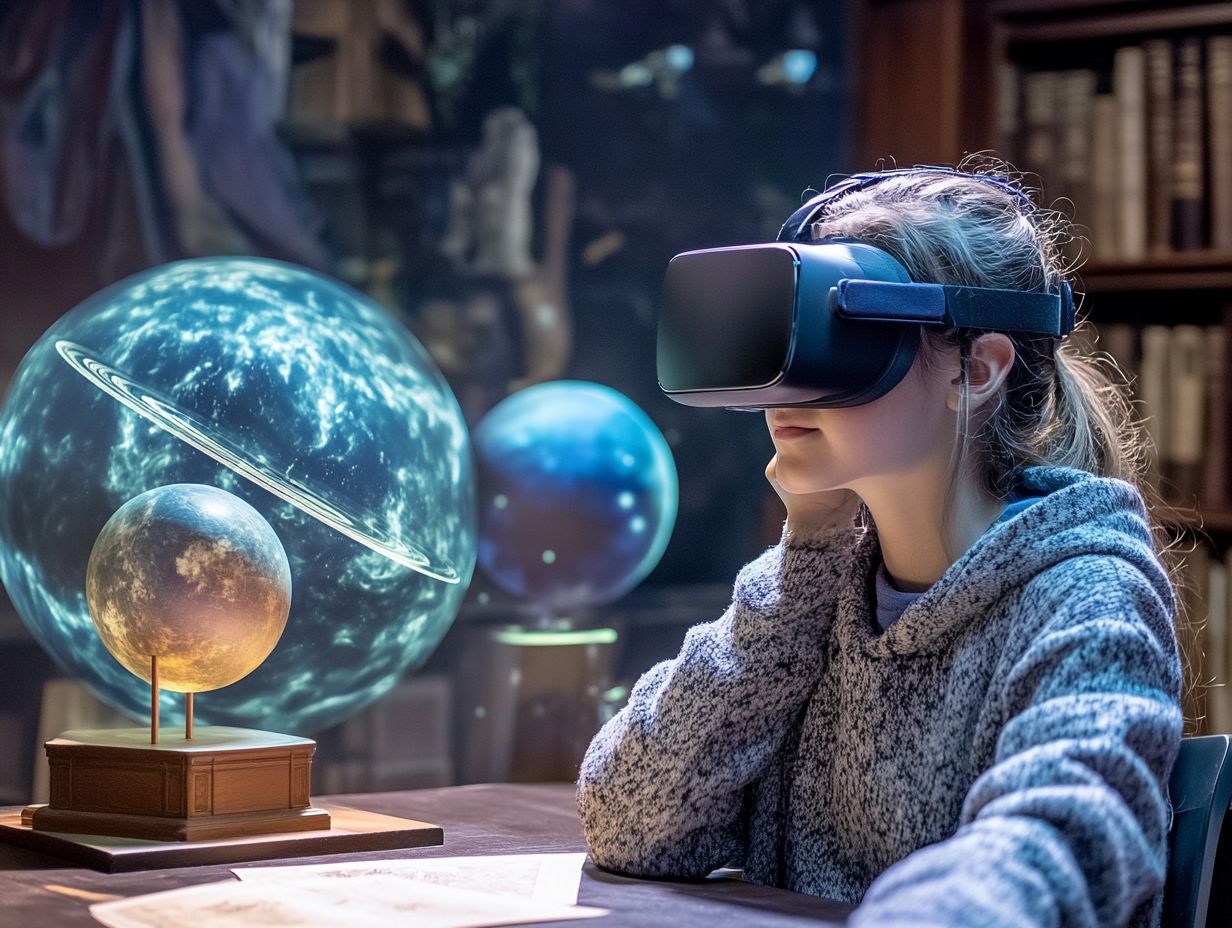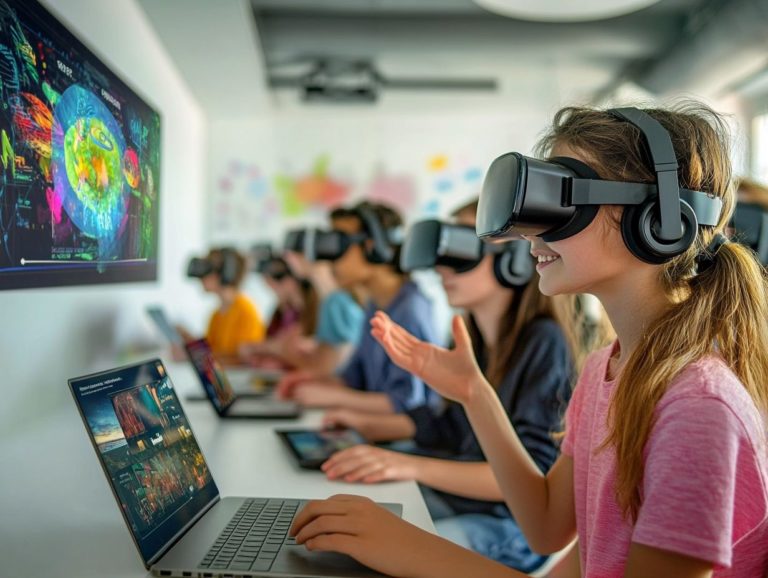The Role of Virtual Reality in E-Learning
Virtual reality (VR) is changing how we learn, providing immersive experiences that traditional e-learning methods simply can’t compete with.
This discussion delves into the benefits of integrating VR into e-learning, highlighting enhanced learning experiences, increased engagement, and potential savings in both time and money.
You ll discover successful case studies from innovative companies and institutions that are harnessing this technology. We will also address the challenges and limitations that accompany it.
Let s dive into the future of VR in education and the growth opportunities that await. Don t miss out on this exciting journey into the transformative world of virtual reality in e-learning!
Contents
- Key Takeaways:
- Benefits of Using Virtual Reality in E-Learning
- Real-World Success Stories: Virtual Reality in Action
- Challenges and Limitations of Virtual Reality in E-Learning
- Future of Virtual Reality in E-Learning
- Frequently Asked Questions
- What is the role of virtual reality in e-learning?
- How does virtual reality enhance e-learning?
- Can virtual reality be used for all types of e-learning?
- What are the advantages of using virtual reality in e-learning?
- Are there any limitations to using virtual reality in e-learning?
- How can virtual reality be incorporated into traditional e-learning methods?
Key Takeaways:

- Experience enhanced learning with VR by immersing learners in simulated environments, making it a powerful tool in e-learning.
- Boost engagement and retention rates through VR, leading to more effective learning outcomes.
- Achieve cost and time savings by implementing VR in e-learning compared to traditional methods, offering a more efficient and cost-effective learning solution.
Defining Virtual Reality and E-Learning
Virtual Reality (VR) and E-Learning are redefining the educational landscape. They combine cutting-edge technologies to elevate your learning experience. With VR, you gain access to immersive, interactive environments that simulate real-world scenarios, transforming online education into something truly enriching.
These immersive experiences give the power for you to tackle complex problem-solving and critical thinking exercises skills that traditional methods often struggle to cultivate.
By engaging in training simulations, you can practice your skills in a risk-free setting, acquiring invaluable experience that s hard to replicate elsewhere.
Thanks to advancements in VR technology, remote education is now more interactive and visually stimulating. This effectively breaks down the barriers typically associated with distance learning.
As educational institutions adopt these innovative approaches, integrating VR into E-Learning not only enhances the content but also nurtures a vibrant community of engaged learners who are better equipped to face real-life challenges.
Benefits of Using Virtual Reality in E-Learning
The integration of Virtual Reality in E-Learning presents a wealth of benefits. These benefits transform your engagement with content and interaction within your educational environment.
By offering immersive experiences, VR elevates learner engagement and ignites motivation, leading to remarkable improvements in knowledge retention.
The incorporation of gamification elements makes learning more enjoyable and fosters a deeper connection to the material.
Virtual educational field trips enable you to explore complex concepts in a hands-on manner, seamlessly bridging the gap between theoretical knowledge and real-world applications.
Enhanced Learning Experience
An enhanced learning experience through Virtual Reality is transforming traditional education methods. It immerses you in interactive environments that foster a deeper understanding and retention of information.
This innovative instructional design leverages VR technology to create user-friendly interfaces, making complex topics more accessible and comprehensible for every type of learner.
Consider medical students; they can practice surgical procedures in a virtual operating room, honing their skills without the risk of harming real patients.
Imagine history lessons coming to life as you explore ancient civilizations through immersive reconstructions. You can walk the streets of ancient Rome or witness a day in the life of Mayan culture.
These experiences not only enhance engagement but also cater to various learning styles. Visual learners thrive on the vivid imagery, while kinesthetic learners benefit from hands-on practice. Ultimately, these applications demonstrate how VR can bridge the gaps in traditional instructional methods, revolutionizing the way education is experienced.
Increased Engagement and Retention
The integration of Virtual Reality in educational settings significantly elevates your engagement and enhances knowledge retention. It effectively tackles the issue of short attention spans in traditional learning environments.
By incorporating game-like features, VR captures your interest and encourages active participation. This leads to a more impactful learning experience.
This immersive technology allows you to engage with content in a profoundly interactive manner. It transforms passive learning into an adventurous exploration.
When you interact with educational material through VR, it stimulates multiple senses. This solidifies your memory and understanding far beyond typical methods.
The psychological benefits of gamification such as immediate feedback, goal achievement, and structured challenges play a vital role in motivating you to dive deeper into subjects. As you navigate through virtual worlds, your focus sharpens, significantly improving your retention of knowledge through repetition and hands-on application.
In essence, this innovative approach not only addresses short attention spans but also fosters a lifelong passion for learning.
Cost and Time Savings

Embracing Virtual Reality in E-Learning can lead to impressive cost and time efficiencies. This makes it a savvy choice for educational institutions and organizations alike.
With the capabilities of remote learning, VR eliminates the burdens of physical travel and logistics. This grants you flexible access to resources and training simulations that ultimately save both time and money.
These efficiencies translate to reduced expenses associated with traditional classroom setups. Think rent and materials, as well as fewer instructor hours.
For instance, organizations utilizing VR platforms have reported up to a 40% reduction in training costs while also slashing course completion times by nearly half.
This shift lets educators spend more time engaging with students instead of dealing with logistics. Imagine learning from anywhere in the world!
With advancements in technology, learners can now immerse themselves in experiences from anywhere. This greatly enhances the allure of virtual environments in education.
Real-World Success Stories: Virtual Reality in Action
Examining case studies of successful Virtual Reality implementation in E-Learning unveils the transformative power of this technology. It drives educational innovations across diverse sectors.
You ll find that numerous companies and institutions have embraced VR to revolutionize their training programs. This has led to impressive improvements in learner engagement, knowledge retention, and overall educational outcomes.
Examples of Companies and Institutions Using VR in E-Learning
Several distinguished companies and institutions, such as Google, Microsoft, NASA, Toyota, Siemens, and the US Military, have adeptly woven Virtual Reality into their E-Learning initiatives. These examples showcase a wide array of applications, ranging from skill-based training to immersive simulations that significantly elevate the learner experience.
For instance, Google s Chrome Canvas VR gives you the power to create art in a 3D space. This nurtures creativity while enhancing your understanding of spatial relationships. Microsoft uses its HoloLens technology a mixed reality headset in Mixed Reality training programs. This allows healthcare professionals to practice surgical procedures in a risk-free environment, boosting precision and safety.
NASA approaches astronaut training with real-time simulations of space environments, deepening your grasp of the challenges you may encounter. Similarly, Toyota employs VR for its manufacturing workforce. It provides hands-on experience with assembly-line tasks, dramatically shortening the learning curve.
Siemens integrates VR into its electrical engineering courses, enabling you to assemble and troubleshoot complex systems in a virtual space. This ultimately enhances your technical aptitude. Meanwhile, the US Military uses VR for tactical training, immersing soldiers in realistic combat scenarios that prepare them for real-world challenges. This sharpens decision-making skills under pressure.
Challenges and Limitations of Virtual Reality in E-Learning
While the advantages of incorporating Virtual Reality into E-Learning are substantial, there are various challenges and limitations to consider.
These may involve tech requirements that demand advanced hardware and software, as well as accessibility concerns for diverse learners. Financial implications tied to the development and upkeep of VR educational programs are also significant.
Technical Requirements and Accessibility
Tech requirements for VR in E-Learning can be real barriers. Not every learner has access to the necessary hardware or reliable internet connectivity to fully immerse themselves in innovative learning experiences. Ensuring equitable access to VR technology is crucial for unlocking its educational potential.
This includes computers with fast processors and enough memory or standalone headsets, which can be financially challenging for many. User-friendly software like VR platforms and educational applications is also essential. A stable internet connection is vital for downloading content and facilitating smooth interactions within virtual environments.
These tech barriers can alienate underprivileged individuals and those in rural areas with poor connectivity. Therefore, educators must account for these factors when crafting inclusive strategies. By embracing the diverse needs of learners, they can foster broader participation in immersive educational experiences.
Cost and Implementation Challenges

When considering the integration of Virtual Reality in E-Learning, cost and implementation challenges are significant factors. Developing training simulations and educational innovations can be quite financially demanding. Weighing the benefits is essential to determine the necessary financial investment for successful VR deployment.
Your initial investment will likely cover hardware, software development, and content creation. Conducting a thorough cost-benefit analysis is crucial. Ongoing maintenance expenses such as software updates and technical support also contribute to the financial burden. The return on investment may not be immediate; integrating VR technology into traditional curricula often requires extensive training for educators and adaptation time for students.
Navigating these complexities is vital to ensure that the long-term gains in engagement and learning outcomes truly justify the upfront expenses.
Advocating for equitable access to VR and exploring its potential benefits in education can lead to transformative experiences for learners. Join the conversation on how VR can reshape the future of E-Learning!
Future of Virtual Reality in E-Learning
The future of Virtual Reality in E-Learning presents an array of promising opportunities for growth and innovation. As VR technology continues to advance, educational institutions are increasingly adopting immersive experiences.
You can expect significant growth in learner engagement and personalized learning. Effective skill-based training will also see remarkable improvements. The possibilities are thrilling and truly transformative.
Predictions and Potential for Growth
Predictions for the growth of Virtual Reality in E-Learning indicate that technological advancements will make VR adoption more prevalent in various educational settings. This growth will be fueled by enhanced game-like elements designed to engage learners more deeply and improve overall learning outcomes.
Developments in hardware, such as more affordable headsets and superior graphics capabilities, will make VR more accessible to educational institutions. This will open new doors for the learning experience.
Market trends suggest a rising tide of investment from both private and public sectors, aimed at weaving immersive technologies into traditional curriculums. As a result, the interactive nature of VR fosters a deeper connection with the material, leading to more invested and motivated learners.
Blended learning models are set to incorporate sophisticated simulations. These will allow learners to practice real-world scenarios within a safe environment. This combination paints an exciting and promising picture for the future of education.
Frequently Asked Questions
What is the role of virtual reality in e-learning?
Virtual reality allows for immersive and interactive learning experiences, making it a valuable tool in e-learning. It enhances engagement and retention of information, while providing a more realistic and practical learning environment.
How does virtual reality enhance e-learning?

Virtual reality enables the creation of simulations and scenarios that are impossible in traditional e-learning methods. This improves understanding and the practical application of concepts and skills.
Can virtual reality be used for all types of e-learning?
Yes, virtual reality can be utilized for a variety of subjects and topics in e-learning. It is particularly effective for training in technical skills, such as medical procedures or engineering simulations.
What are the advantages of using virtual reality in e-learning?
Virtual reality in e-learning provides a more engaging and interactive learning experience. This leads to increased motivation and retention of information. Additionally, it can save time and resources by eliminating the need for physical equipment or real-life scenarios.
Are there any limitations to using virtual reality in e-learning?
One limitation of virtual reality in e-learning is the cost of equipment and development. It may not be feasible for all institutions or organizations to invest in VR technology. Moreover, some learners may experience motion sickness or other physical discomfort while using virtual reality.
How can virtual reality be incorporated into traditional e-learning methods?
Virtual reality can supplement traditional e-learning methods, such as online courses or webinars. It can also be incorporated into blended learning approaches, where VR activities are combined with face-to-face instruction.






